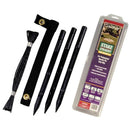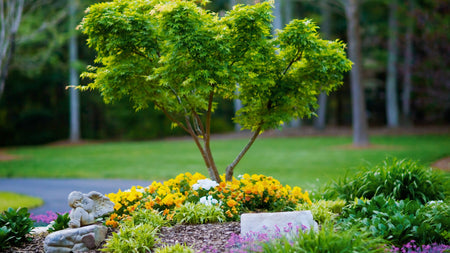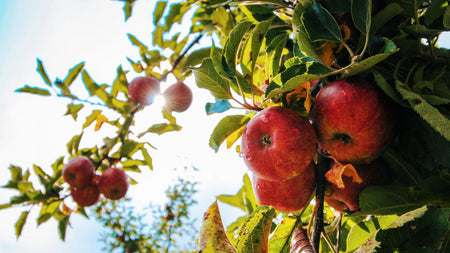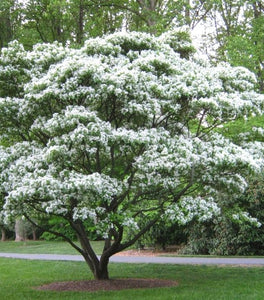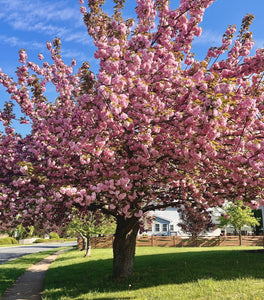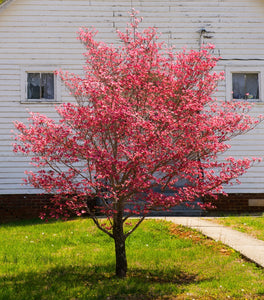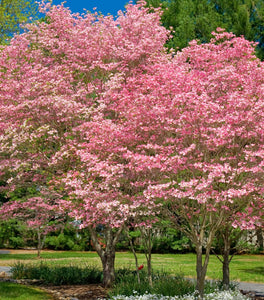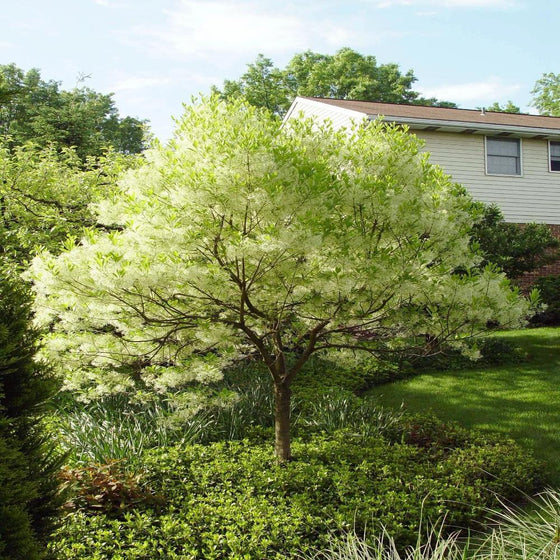
Images Depict Mature Plants
American Fringe Trees for Sale Online
American Fringe Tree (Chionanthus virginicus) is a beautiful, native deciduous tree known for its stunning display of fragrant, airy white flowers that bloom in late spring. Often referred to as "Old Man's Beard" due to its unique, fringe-like blossoms, this tree adds a delicate and elegant charm to any landscape. The clusters of white, slightly fragrant flowers drape from the branches, creating an eye-catching and soothing cloud-like effect. Thriving in USDA Hardiness Zones 3-9, the American Fringe Tree is highly adaptable to various climates, making it an excellent choice for many gardens across the United States. This tree is an exceptional addition for those looking to enhance their garden's seasonal interest and attract pollinators, as bees and butterflies love it.
American Fringe Tree typically grows to a mature height of 12-20 feet, with a similar spread, making it suitable for smaller yards as well as larger landscapes. Its multi-stemmed or single-trunk form gives gardeners flexibility in design, allowing it to be used as a specimen tree, an understory planting, or even as a focal point in a mixed border. In the fall, the glossy, dark green leaves turn a warm golden-yellow, providing another season of visual appeal. The female trees also produce clusters of blue-black fruits that ripen in late summer, attracting birds and other wildlife to the garden. This versatility makes the American Fringe Tree a valuable ornamental feature for enhancing biodiversity while creating a picturesque landscape.
In terms of care, the American Fringe Tree is relatively low maintenance, preferring full sun to partial shade and thriving in moist, well-drained soil. It can tolerate a range of soil types, including clay and loam, which makes it adaptable to different garden conditions. Drought-tolerant once established, it also requires minimal pruning, needing only occasional removal of dead or damaged branches. Whether planted as a stand-alone ornamental, along a woodland edge, or paired with other native species, the American Fringe Tree will add year-round interest and natural beauty to your landscape, making it a cherished addition to gardens seeking both form and function.


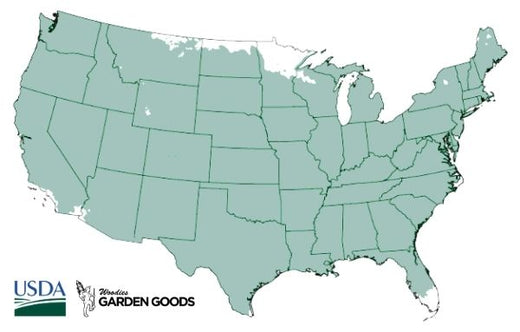
| Hardiness Zone: | 3-9 |
|---|---|
| Mature Height: | Up to 20 Feet |
| Mature width: | 15 to 20 Feet |
| Classification: | Broad leaved deciduous tree, spring flowering |
| Sunlight: | Full sun |
| Habit: | Upright, dome shaped canopy |
| Foliage: | Dark green, yellow fall color |
| Flower Color: | Pure white |
| Pruning Season: | No pruning needed |
| Soil Condition: | Any well drained soil |
| Water Requirements: | Water well until established |
| Uses: | Tolerates moist soil and full sun. Add to native and wild gardens for habitat and seasonal interest; will adapt to drier sites |
How to Care for American Fringe Tree
Before you buy an American Fringe Tree, make sure to read about the recommended care instructions to keep this plant healthy and thriving.
How do I Plant my American Fringe Tree?
To plant your American Fringe Tree, start by selecting a location that receives full sun to partial shade, as this will ensure the best flowering display and overall growth. This versatile tree prefers moist, well-drained soil, but it is also tolerant of a variety of soil types, including clay and loam. Dig a hole that is twice as wide and slightly deeper than the root ball to give the roots room to spread and establish. Place the tree in the hole, ensuring that the top of the root ball is level with or just above the surrounding soil. Fill in the hole with the excavated soil, gently firming it down to eliminate air pockets, and water thoroughly to help the roots settle. Spacing your American Fringe Tree 15 to 20 feet away from other trees or structures will allow for proper airflow and room for its canopy to mature. After planting, it is essential to keep the soil consistently moist, especially during the first growing season, to help establish a strong root system. Mulch around the base of the tree with a 2-3 inch layer of organic mulch, such as shredded bark or compost, to retain moisture, regulate soil temperature, and suppress weeds. Keep the mulch a few inches away from the trunk to prevent rot. Once established, the American Fringe Tree requires minimal care, as it is relatively drought-tolerant and resistant to pests and diseases. Its attractive white blossoms, glossy green leaves, and golden fall foliage make it a beautiful addition to landscapes, whether used as a specimen tree, in woodland gardens, or along a mixed border.
How do I water American Fringe Trees?
Watering American Fringe Trees properly is essential for ensuring their healthy growth and abundant flowering. During the first growing season, it's important to keep the soil consistently moist to help the tree establish a strong root system. Water deeply once or twice a week, especially during dry periods, making sure the top 2-3 inches of soil remain damp but not waterlogged. A deep, thorough watering encourages the roots to grow deeper, increasing the tree's resilience to drought. Use a soaker hose or water at the base of the tree to avoid wetting the leaves, which can help prevent fungal issues. As a rule of thumb, providing about 1 inch of water per week is ideal, adjusting based on weather conditions and soil type. Once established, American Fringe Trees are moderately drought-tolerant, but they will perform best when provided with consistent moisture. During prolonged dry spells or periods of high heat, it is important to provide supplemental water to keep the soil from drying out completely, as this can stress the tree and reduce flowering. Adding a 2-3 inch layer of organic mulch around the base of the tree helps to retain soil moisture, minimize evaporation, and keep the roots cool. Make sure to keep the mulch a few inches away from the trunk to prevent rot. By ensuring your American Fringe Tree receives adequate water, you can enjoy its stunning, fringe-like white flowers and lush green foliage for many years to come.
How do I fertilize American Fringe Trees?
Fertilizing American Fringe Trees is an important step to encourage healthy growth, vibrant foliage, and an abundant display of its beautiful, fragrant white flowers. In early spring, before new growth begins, apply a slow-release, balanced fertilizer, such as a 10-10-10 or 14-14-14 formulation, around the base of the tree. Spread the fertilizer evenly, starting a few inches from the trunk and extending to the tree’s drip line. This will ensure that the nutrients reach the root zone effectively without causing root burn. Water thoroughly after applying fertilizer to help nutrients penetrate the soil and be absorbed by the tree's roots. American Fringe Trees also benefit from an annual application of organic compost, which can be used in addition to or as an alternative to chemical fertilizers. A 2-3 inch layer of compost spread around the base of the tree in early spring will provide a slow-release source of nutrients while improving soil structure and moisture retention. Avoid over-fertilizing, as too much nitrogen can lead to excessive foliage growth at the expense of flowering. Proper fertilization will support your American Fringe Tree in producing its showy, fringe-like blooms and help maintain its vibrant green foliage, enhancing its ornamental value in your garden.

How do I prune American Fringe Trees?
Pruning American Fringe Trees is essential to maintaining their natural beauty and ensuring healthy growth and abundant blooms. The best time to prune your American Fringe Tree is in late winter or early spring, while the tree is still dormant and before new growth begins. Begin by removing any dead, damaged, or diseased branches to improve the overall health of the tree and encourage better air circulation. Use clean, sharp pruning shears to make clean cuts just above a branch collar or bud to help the tree heal properly. If the tree has multiple trunks or a bushy habit, you can thin out the interior growth to enhance its structure and allow light to reach the center of the tree. Light shaping and maintenance pruning can also be done immediately after the tree finishes flowering in late spring. Pruning at this time helps maintain the desired shape without sacrificing next year's blooms, as American Fringe Trees form flower buds on old wood. Avoid heavy pruning, as this can reduce the number of flowers produced in the next season. Focus on removing any crossing branches, suckers, or water sprouts that may detract from the tree's natural form. By pruning your American Fringe Tree correctly, you will promote healthy growth, prevent disease, and enjoy the elegant, cascading fringe-like flowers that make this tree such a stunning feature in the landscape.










